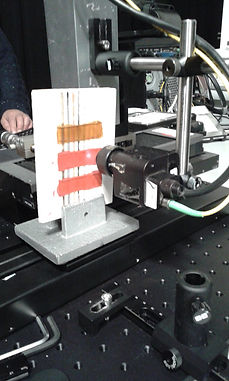The Impact of Lasers on Mural and Easel Paintings: Consequences of irradiation on the preservation of Works of Art
OVERVIEW
In the last few decades lasers have been extensively used in the field of Heritage Science and Conservation. Techniques such as Raman spectroscopy use continuous wave (CW) lasers at different wavelengths to identify materials such as pigments. Laser ablation (LA) is used to selectively remove undesired materials on artworks. Laser induced breakdown spectroscopy (LIBS) is used for elemental materials characterisation.
As with any interaction with cultural heritage objects, the benefit of the analysis results obtained must be balanced with any harm incurred, and steps must be taken to minimise the potential of damage to the object.

Damage by a high intensity laser viewed under a microscope
However, the literature regarding possible damage caused by radiation is very limited. Whilst it is known that an intense radiation can modify the physical, chemical, mechanical or optical functional response of materials either temporarily or permanently, safe parameters for analysis have yet to be established.
The focus of this project is to study the effects of lasers on paintings.
The aims of the project are:
-
To develop an online monitoring method combining various spectroscopic techniques;
-
To identify the safety and potential harmfulness of CW and pulsed lasers on paintings.
Addressing the challenge
To address the research question, an initial survey is being conducted on modern oil paint samples, which have been prepared in the same way as oil paints for easel paintings. Each paint sample is assessed both before and after the use of laser based Raman analysis. The assessment consists of a series of non destructive analysis techniques: hyperspectral imaging, thermal imaging and optical coherence tomography (OCT). This allows us to document the degradation of the pigment sample caused by the Raman laser at different intensities and for different exposure times. Depending on the type of laser and the irradiated material, we are able to identify both subtle, reversible changes to the object as well as instances of more permanent damage. Further work is planned to assess other material parameters, such as different binders and different substrates.

Paint samples undergoing Raman analysis at different intensities
Making a difference
This research will develop knowledge of laser-material interactions used both in ‘non-destructive’ laser based imaging and spectroscopy, and laser ablation (LA) for ‘micro-destructive’ analysis and removal of unwanted materials. This is an important step towards the ultimate goal: identifying safe irradiation conditions for laser-based techniques applied to Cultural Heritage materials. It may not be possible to create a universal protocol for the analysis of complex historical objects, as each object will differ in terms of materials present, age and current condition. However, understanding the parameters which cause observable side effects will allow us to establish safe usage thresholds. These, plus the development of multimodal monitoring techniques for assessing individual objects prior to and during analysis, will help to minimize damage while data is collected to answer curatorial and conservation research questions.
people
Academic Supervisor:
Professor Haida Liang (Nottingham Trent University)
Academic Co-Supervisors:
Dr Ian Shuttleworth (Nottingham Trent University)
Dr Cristiano Riminesi (ISPC-CNR)
Dr Costanza Miliani (ISPC-CNR)
Research Fellows:
Dr Chi (Sammy) Cheung (Nottingham Trent University)
PhD Student:
Maria Amelia Suzuki (Nottingham Trent University)
sponsors
Institute of Heritage Science- National Research Council, Florence
IPERION HS “Integrating Platform for the European Research Infrastructure”
H2020-INFRAIA-2019-1 under Grant No. 871034
Nottingham Trent University
